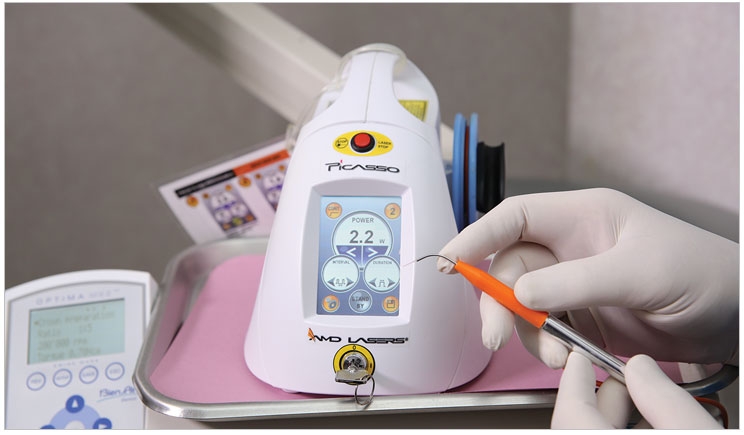
Modern technology has increased the expectations of dental patients. They desire less radical and painful procedures with minimal bleeding, more effective healing, and greater precision—all with fewer dental visits.
The use of laser technology in almost every area of our lives has become more prominent, including entertainment, computer printers, imaging devices, military equipment, and, of course, dentistry. Practices that use or plan on using lasers need to keep several issues in mind, including:
- Safety
- Employee education
- Marketing
- Revenue channels
- Advantages
- Considerations before buying equipment
Safety
Lasers are useful and highly effective. Yet their potential hazards have spurred standards, regulations, and legislation from government and non-government bodies alike to establish safe procedures that all dental staff and patients must follow.1
For example, the US Department of Labor’s Occupational Safety and Health Administration sets workplace safety standards. The US Food and Drug Administration’s Center for Devices and Radiological Health provides oversight of the manufacture, operation, and safe use of all medical devices.3
The American National Standard Institute (ANSI) issues guidelines for the implementation of safety measures for the use of laser systems. And in Europe, the International Electrotechnical Commission (IEC) regulates laser safety via its IEC 60825-1 standard.
Globally, procedures are now in place for all dental laser use. Treatment can not begin without all of the items on a specific checklist, which includes:
- Masks
- Protective goggles
- Device safety procedures
- A dedicated laser safety officer
- Entry restriction of unauthorized personnel to the operating environment
- Caution signs
- Non-reflective equipment
Employee Education
The key to success, sustained growth, and staying ahead of the competition in today’s rapidly changing environment is an effective knowledge acquisition program. Many conferences, workshops, seminars, lectures, and continuing education (CE) courses are available from organizations like the Academy of Laser Dentistry (ALD) to help all employees learn about the latest practices.2,3
The ALD was founded in 1993 as a body dedicated to research and clinical education, as well as the creation of guidelines and standards to ensure the safe and effective use of laser technology anywhere in the world. Membership cuts across a wide range of top academics, researchers, and clinicians who use lasers. Its programs, academies, and courses are useful for a better knowledge of physics and of the safest and most effective ways to use lasers.
Marketing
Most times, people misinterpret marketing to mean selling. While selling entails a simple and straightforward transaction of exchanging money for a service or product, marketing involves much more.
Marketing is an art, providing the customer with superior value and educating the patient about the quality of the service offered. It is worth addressing whenever the issue of dental laser practice management comes up and is the essential element that makes dental practice successful.4,5
Marketing consists of three methods of content delivery: word of mouth, online, and offline. Word-of-mouth marketing is the best of the three for any dentist. It does not cost a penny. The only part a dentist needs to play is to provide exceptional service and the patients will spread the news about the good work. Dentists do not have to leave the office to set this marketing rolling. They accomplish it right there in the operatory.
Online marketing uses the Internet for advertising. Emails, social networks, websites, and blogs all are online channels for delivering marketing content to the public. Unlike other forms of marketing, online marketing can reach thousands and even millions of people within a very short period. In addition, online efforts typically have a longer lifespan, and you can conveniently edit and customize them as the need arises.8
Offline marketing has the largest price tag. Although the investment is high, it has a very wide reach and is effective in creating product awareness. Its three main methods of delivery are radio, television, and print ads.
For the best results, create a plan that incorporates word-of-mouth, online, and offline marketing to tap into all of their advantages. You also may consider promoters, publicists, and professional marketing outfits to support your large-scale promotion efforts.
This will help you spend your marketing budget prudently. For instance, you can include your Web address in your newspaper ads to drive potential patients to your site for real-time interaction.
Revenue Channels
Dentistry is a business, and dentists expect profitability. So, research how you can enhance your efficiency. Recruit the best employees, stay up to date with today’s innovations, and procure the latest technology to ensure faster procedures. You’ll see an increase in production turnover, which is a huge influence on practice profitability.
Patients are ready to learn about and accept new laser procedures as long as they can improve the treatment experience. Lasers also enable you to charge a little more. To determine how much you should charge for a laser procedure, check it per segment or per tooth. Or, the duration of the procedure may be used to determine the final cost of treatment.5,11
Patients rarely oppose this extra charge because they know the laser is faster and more comfortable, and it can achieve better results in less time. Therefore, they consider the service a good value. These extra charges make it possible for you to recoup the capital invested in acquiring the technology in a very short time. Everybody benefits.
Advantages
Dental procedures have grown less radical. They strive for more conservative approaches that focus only on the affected tooth without interfering with its surrounding areas and functions.
With their aggressive development, dental lasers have found their way into orthodontics, endodontics, oral and maxillofacial surgery, periodontics, aesthetic dentistry, restorative dentistry, prosthodontics, dental implantology, and pediatric dentistry.9,10
Many people think lasers are new to dentistry. Lasers actually got their start in dentistry in 1964. Yet the lack of laser awareness is largely because of dentists’ reluctance to incorporate them into their regular clinical practice, despite the many inherent benefits they offer in expanding dental practices.
With lasers, patients are more relaxed because of the absence of the nauseating smells, jarring vibration, and scary noises produced by other tools like drills and reagents. In addition, most laser procedures do not require any anesthesia, which is usually the norm with standard treatment. These positives help encourage more patients, especially those who were adverse to standard dental procedures, to easily accept laser treatment.2,9,10
Also, lasers help dentists perform dental procedures across all segments and age groups with greater time efficiency. Treatments for pediatric and special needs patients have improved and are continuously expanding because of happy referrals from their caregivers.1,9
Lasers have enabled procedures that are more comfortable for elderly patients as well. With lasers, older patients who usually have a myriad of other age-related ailments have been able to access proper dental treatment without aggravating their other conditions.
Considerations Before Buying Equipment
Everything we have considered so far will make no sense if we buy the wrong type of dental laser equipment. Dentists must make certain considerations and come up with a guide that will enable them to choose the right gear.7,8
Dentists first must identify the areas of their practices that will truly benefit from the use of the laser. Equipment ergonomics is another significant consideration before procuring any laser device. Many types of lasers are available today, with unique clinical applications, including:
- Carbon-dioxide lasers, which are very important for oral surgery
- Erbium lasers, which are useful as drill replacements in certain conditions
- Argon lasers, which are convenient for composite curing and surgical procedures for soft tissues
- Neodymium-doped yttrium aluminum garnet (Nd:YAG) and diode lasers, which can be used for minor soft tissue surgery
Most of these lasers can serve effectively in both aesthetic dentistry and periodontal treatment. Any dentist whose practice focuses on soft tissue treatment, then, will find any of the available laser wavelengths suitable. But if the dentist treats both soft and hard tissues, an erbium laser will provide a complete set of tools to handle a wider range of dental procedures.2,5,8
Dental patients are more comfortable with laser procedures because the equipment is silent. It does not have the vibration noise of conventional dental drills. In addition, lasers have some disinfection properties and can lower the temperature of the pulp, unlike a high-speed drill. Other beneficial laser clinical effects that have attracted recent attention include:
• Pain relief
• Hardened enamel
• Reduced inflammation
• Reduced sensitivity
• Faster healing
The acceptance and popularity of dental lasers are growing. This is attributable to how portable and light they have become, with more maneuverability inside the oral chamber. One crucial question that bothers potential buyers is whether they will be able to recoup any investment in acquiring one.
Several papers have discussed whether their advantages justify their costs. From our interactions with different bodies worldwide, we have yet to see any dentist who has successfully incorporated laser treatment and witnessed a dwindling practice.
Fortunately, there has been a sharp decline in the cost of lasers. Diode lasers previously cost as much as $15,000 in the United States, but you can get most of them now for $2,500 to $5,000.
Conclusion
Dental lasers will hold a very important place in the future of any dental practice. Their integration will surely increase the number of possible dental procedures, with greater benefits for patients and more profits for practitioners.
References
- Convissar RA, ed.The Dental Clinics of North America: Laser and Light Amplification in Dentistry. Philadelphia, PA: WB Saunders; 2000:907-916.
- Coluzzi DJ, Convissar RA. Atlas of Laser Applications in Dentistry. Chicago, IL: Quintessence Publishing; 2007.
- Lackey AD. Intra-oral video photography: questions and answers. J Calif Dent Assoc. 1991;19:29-32.
- Rosenberg S. Take your practice to the next level.Dent Pract Rep. 2003:48-49
- Schwab D. What your staff needs to know about marketing your practice. Dent Econ. 1999;89:50-53, 95.
- Christensen GJ. What is the role of specialties in dentistry? J Am Dent Assoc. 2003;134:1517-1519.
- Freedman G. Buyers’ guide to curing lights. Dent Today. 2003;22:140-151.
- Weiner GP. Laser dentistry practice management. Dent Clin North Am. 2004;48:1105-1126, ix.
- Manni JG. Dental Applications of Advanced Lasers (DAAL). Burlington, MA: JGM Associates; 2007.
- Coluzzi DJ. Lasers in dentistry [letter]. J Am Dent Assoc. 2004;135:696-697.
- Spaeth D. Not your father’s dentistry. Dent Pract Rep. 2003:27-34.
 Dr. Saurabh Gupta, MDS, has a master’s degree in oral and maxillofacial surgery and has been in surgical practice since 2014. During his initial years after specialization, he trained himself in various allied surgical disciplines including implantology and laser dentistry. He is also involved in cosmetic dentistry including smile design as well as botox and fillers. Additionally, he has a particular interest in anxiety and pain management in dental surgery. He can be reached at saurabh.ravzz@gmail.com.
Dr. Saurabh Gupta, MDS, has a master’s degree in oral and maxillofacial surgery and has been in surgical practice since 2014. During his initial years after specialization, he trained himself in various allied surgical disciplines including implantology and laser dentistry. He is also involved in cosmetic dentistry including smile design as well as botox and fillers. Additionally, he has a particular interest in anxiety and pain management in dental surgery. He can be reached at saurabh.ravzz@gmail.com.
 Dr. Rubina Khatoon, BDS, graduated from Rajiv Ghandhi University in India in 2014. She has worked in private practice in Bangalore, India, as a general dentist with an interest in cosmetic dentistry. She also has a special interest in implant and laser dentistry. She has been involved in clinical laser research as well. In her private practice, she focuses on pain management, occlusion, and smile design. She can be reached at rubinakhatoon72@outlook.com.
Dr. Rubina Khatoon, BDS, graduated from Rajiv Ghandhi University in India in 2014. She has worked in private practice in Bangalore, India, as a general dentist with an interest in cosmetic dentistry. She also has a special interest in implant and laser dentistry. She has been involved in clinical laser research as well. In her private practice, she focuses on pain management, occlusion, and smile design. She can be reached at rubinakhatoon72@outlook.com.
Related Articles
It’s Not Just Patients Who Hate the Needle











